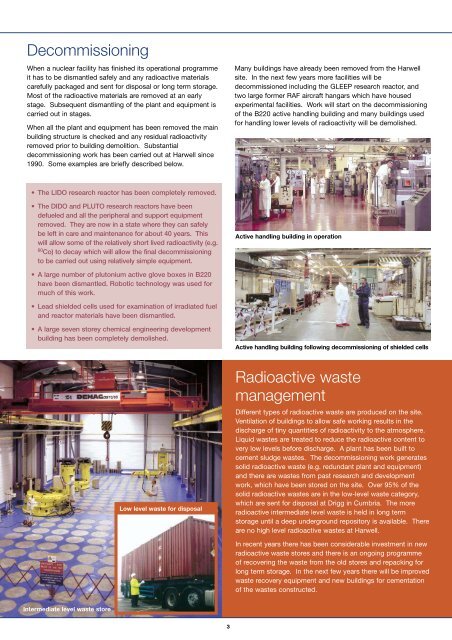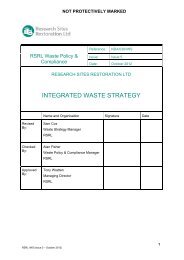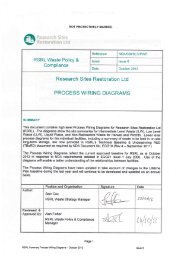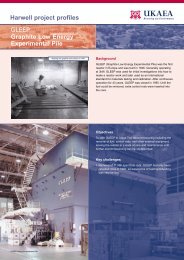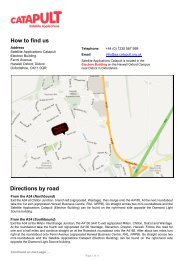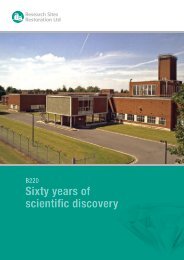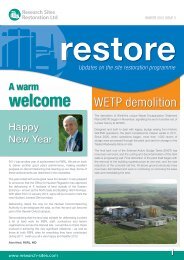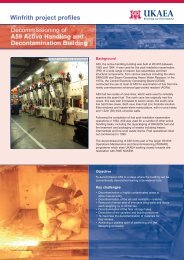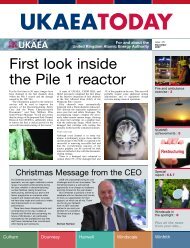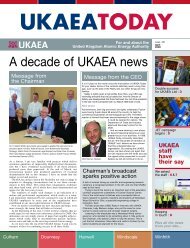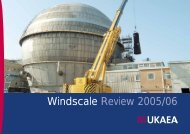Harwell Evolution Brochure - Research Sites Restoration Ltd
Harwell Evolution Brochure - Research Sites Restoration Ltd
Harwell Evolution Brochure - Research Sites Restoration Ltd
- No tags were found...
You also want an ePaper? Increase the reach of your titles
YUMPU automatically turns print PDFs into web optimized ePapers that Google loves.
DecommissioningWhen a nuclear facility has finished its operational programmeit has to be dismantled safely and any radioactive materialscarefully packaged and sent for disposal or long term storage.Most of the radioactive materials are removed at an earlystage. Subsequent dismantling of the plant and equipment iscarried out in stages.When all the plant and equipment has been removed the mainbuilding structure is checked and any residual radioactivityremoved prior to building demolition. Substantialdecommissioning work has been carried out at <strong>Harwell</strong> since1990. Some examples are briefly described below.Many buildings have already been removed from the <strong>Harwell</strong>site. In the next few years more facilities will bedecommissioned including the GLEEP research reactor, andtwo large former RAF aircraft hangars which have housedexperimental facilities. Work will start on the decommissioningof the B220 active handling building and many buildings usedfor handling lower levels of radioactivity will be demolished.• The LIDO research reactor has been completely removed.• The DIDO and PLUTO research reactors have beendefueled and all the peripheral and support equipmentremoved. They are now in a state where they can safelybe left in care and maintenance for about 40 years. Thiswill allow some of the relatively short lived radioactivity (e.g.60 Co) to decay which will allow the final decommissioningto be carried out using relatively simple equipment.Active handling building in operation• A large number of plutonium active glove boxes in B220have been dismantled. Robotic technology was used formuch of this work.• Lead shielded cells used for examination of irradiated fueland reactor materials have been dismantled.• A large seven storey chemical engineering developmentbuilding has been completely demolished.Active handling building following decommissioning of shielded cellsLow level waste for disposalRadioactive wastemanagementDifferent types of radioactive waste are produced on the site.Ventilation of buildings to allow safe working results in thedischarge of tiny quantities of radioactivity to the atmosphere.Liquid wastes are treated to reduce the radioactive content tovery low levels before discharge. A plant has been built tocement sludge wastes. The decommissioning work generatessolid radioactive waste (e.g. redundant plant and equipment)and there are wastes from past research and developmentwork, which have been stored on the site. Over 95% of thesolid radioactive wastes are in the low-level waste category,which are sent for disposal at Drigg in Cumbria. The moreradioactive intermediate level waste is held in long termstorage until a deep underground repository is available. Thereare no high level radioactive wastes at <strong>Harwell</strong>.In recent years there has been considerable investment in newradioactive waste stores and there is an ongoing programmeof recovering the waste from the old stores and repacking forlong term storage. In the next few years there will be improvedwaste recovery equipment and new buildings for cementationof the wastes constructed.Intermediate level waste store3


